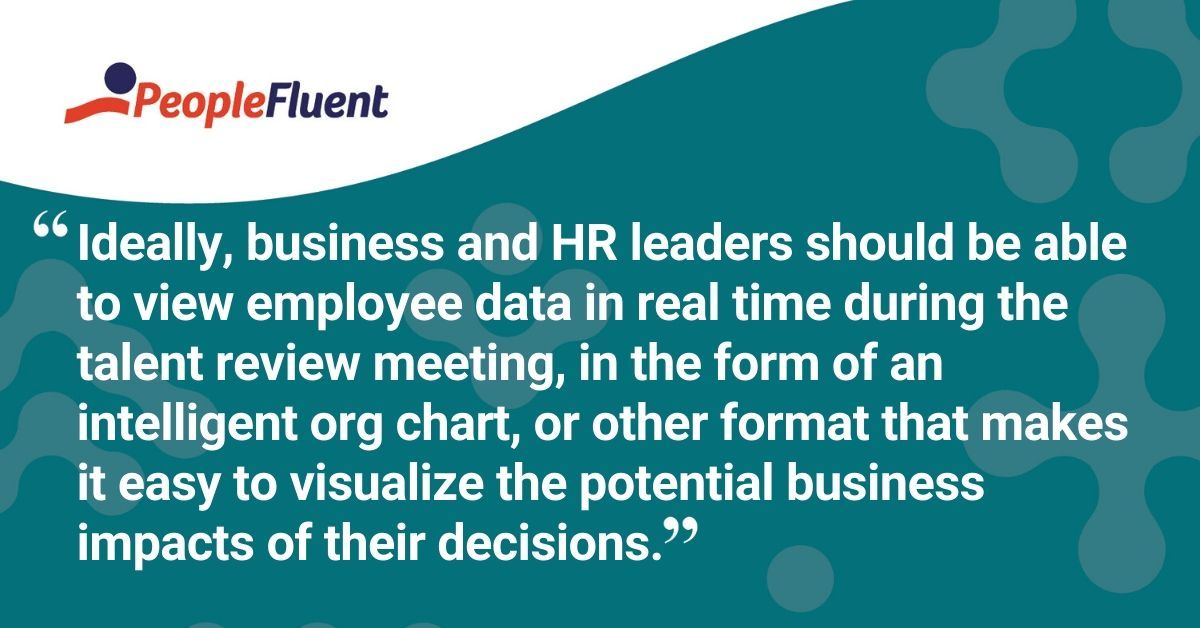Published: Jul 18, 2018Time to read: 4mins Category: Talent Management
How to Get Greater Value from Your Talent Review Meetings
What could be more critical to organizational health than developing bench strength at all levels? Or identifying your top performers—who are, on average, 4 times more productive than the average employee—so you can reward and retain them? Or determining who on your current team has the potential to lead your company into the future?
These are the essential tasks of talent reviews and succession planning. And as with the truism about the value of employees, talent review meetings are perhaps the greatest opportunity companies have to maximize the value of those assets.
What is a Talent Review Meeting?
Fairly common within enterprise organizations, talent review meetings are strategic sessions that take a high-level view of business performance and employee performance. In a talent review, the focus is on company growth and future positions in relation to individual employee appraisal. The talent review process typically brings senior-level stakeholders together to
- Identify key positions that require immediate hire
- Determine whether current talent can fill these positions
- Assess how talent strategies can and will impact overall business performance and company advancement.
To get the most out of talent review meetings, organizations need systematic processes for evaluating talent—a common lexicon, for example, and a consistent approach to rating and review—and accurate data to support talent decisions.

You might also like: '3 Ways to Modernize Your Performance Review Process'
The Nexus of Performance, Development, and Succession
The talent review process should be a disciplined approach that links three things:
- Performance management
- Learning and development
- Succession planning
Individual performance reviews are a critical component of the talent review. But simple rankings of employees based on performance or potential aren’t enough to support strategic decisions that will strengthen an organization. Talent review discussions are greatly enriched when performance reviews capture diverse and frequent feedback.
Employee learning and development supports the talent review process by serving as an action plan for the company, the employee, and his or her manager. To ensure a high-potential employee builds the skills, knowledge, and experience needed to contribute in a future role, his or her development plan should align with business goals at the company and department level.
While succession planning can employ a variety of forms to facilitate discussion, many organizations use a 9-box performance and potential matrix to evaluate talent and determine which employees have the potential to assume greater responsibility. The exercise of populating those boxes helps organizations focus resources on the right talent and understand development needs.
Organizations with talent management systems that integrate performance management, learning and development, and succession planning have a distinct advantage during talent reviews. Leaders can see a clear and accurate picture of each employee’s performance and potential as they populate the succession plan.

Related reading: '6 Foundations for Effective Succession Planning'
Basing Decisions on Data
Perhaps the most important thing an organization can do to improve talent reviews is to ensure leaders have access to current, relevant, and comprehensive workforce data.
Without rich data, it’s difficult to see the connection between individual performance and business performance. Greater visibility into the workforce is key to identifying critical roles, finding talent to fill those roles, and programming development activities that will grow high-potential employees.
Given the complexity of talent review conversations, HR and business leaders need access to robust workforce analytics—including the current organizational structure, unfilled positions and key roles, performance and compensation data, internal talent pools, and more.
Ideally, business and HR leaders should be able to view employee data in real time during the talent review meeting, in the form of an intelligent org chart or other format that makes it easy to visualize the potential business impacts of their decisions.
A Successful Talent Review is a Plan for Success
The outcome of a successful talent review meeting is essentially a roadmap for the company’s future success. With a systematic process for succession planning,
- The company can prepare for expected changes in leadership, like retirements and promotions.
- Leaders can proactively fill existing talent gaps and respond quickly when people in critical roles leave unexpectedly.
- Top performers receive the reward and recognition they deserve, which helps keep them motivated and engaged.
- High-potential employees receive opportunities for focused growth that aligns with their individual career goals, which builds the talent pipeline.
By taking steps to provide leaders with the right systems and data to drive and inform talent reviews, the organization overall will benefit through increased retention, productivity, and business continuity.
More from the blog: '4 Innovative Tactics Your Talent Management Strategy Needs'
Discover How Recruitment Lets You Find the Right People—Fast
PeopleFluent helps you fill critical roles with the right people and the right skillsets on a global scale. At the same time, it helps you build your employer brand and sharpen your competitive edge.